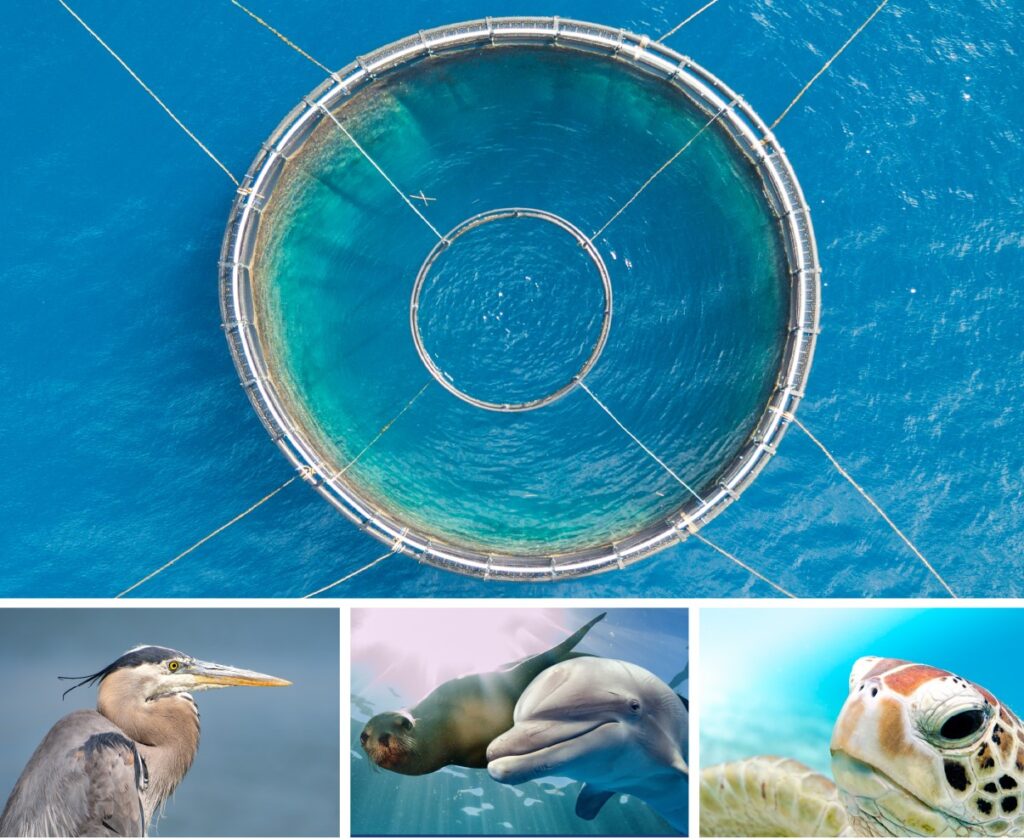As marine aquaculture expands to the open ocean in the United States Exclusive Economic Zone, there is increased concern about how protected species may be affected. We have summarized the state of knowledge regarding interactions of protected species with offshore aquaculture installations to support coastal managers who are making decisions about aquaculture development in U.S. federal waters. This summary will guide industry planning and the regulatory process to develop sustainable open ocean aquaculture that also meets legislative mandates for protected species.
Why We Care
Seafood demand is on the rise globally, but despite having optimal conditions for marine aquaculture growth, the U.S. federal government has not enacted legislation that specifically establishes a consistent and efficient process for offshore aquaculture permitting and regulation.
With an ocean of activities occupying our coastal space, it is important to reach a balance between the use and protection of our natural resources. Sustainable aquaculture development and maintenance should include considerations about how protected species and habitats may be impacted, and every effort should be made to understand and minimize these potential negative interactions.

What We Did
The document we produced provides a summary of the reported cases of protected species interactions with aquaculture gear globally, as well as recommendations to minimize negative interactions of protected species with aquaculture gear.
What We Found
-
- Reported incidents of protected species entanglements are relatively low despite thousands of miles of aquaculture gear in operation around the world.
- Global sentiment is changing regarding concern over economic loss versus environmental, habitat, or species diversity loss. Moving forward, protected species regulations, environmental impact risk assessments, consumer demand, and market competition are driving the importance of responsible aquaculture practices.
- Increased understanding of ecological interactions between farming and marine life coupled with proactive siting techniques and improved net technologies that prevent predation on cultured fish have proven to be an effective strategy for minimizing negative interactions.
Benefits of Our Work
This summary and analysis will strengthen the ability of permitting authorities to make science-based decisions and recommendations as part of the review and consultation process required to permit aquaculture operations in U.S. federal waters.
Regulators must consider the potential impacts farms may have, including habitat exclusion, entanglement, entrapment, collisions, and behavioral modifications as the primary risks posed to protected species by marine aquaculture facilities and operations. Offshore aquaculture development in the U.S. can follow the example set by industry leaders with decades of innovation and environmental stewardship solutions.
Next Steps
-
- The scarcity of reported interactions of protected species with aquaculture gear despite the large amounts of aquaculture gear deployed in the coastal ocean makes it difficult to determine if the paucity of reported incidents is due to low interaction accounts or failure to detect and report them. Future work should focus on how to increase information sharing and reporting capabilities in this sector.
- The long-term effects of non-lethal interactions with aquaculture gear are poorly understood. In response, technological innovation is focused on effective deterrent methods that do not affect non-target species, reducing the risk of interactions, and decreasing harm if contact occurs. Future work should include more information about this topic.
- Upcoming related work includes development of an Entanglement Simulator to inform protected species risk assessment and mitigation, guidance for structural monitoring of offshore aquaculture gear in the U.S., and an aquaculture gear guide summary and best practices.
